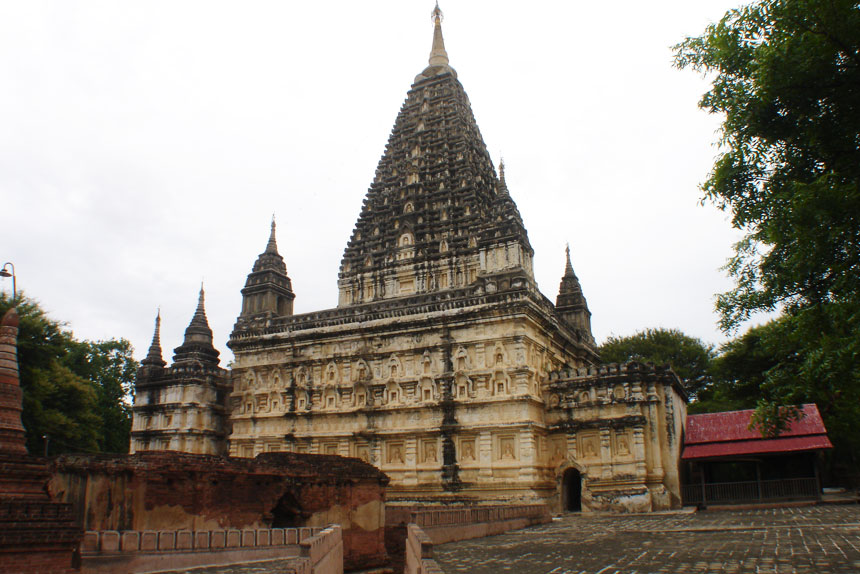Mahabodhi Temple of Bagan was known to have been modelled after the famous Mahabodhi temple in Bodhgaya. Bihar State of India. The original Mahabodhi Temple of India was built during AD 500. It commemorates the spot where the Buddha attained enlightenment; this monument was built during the reign of King Nantaungmya (1211-34).
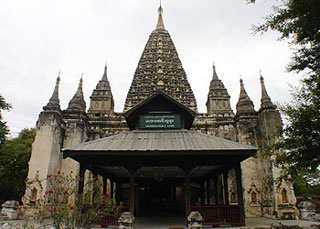 |
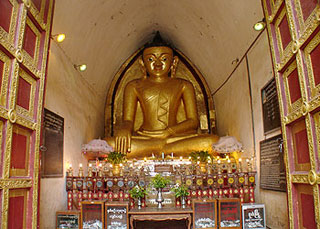 |
History
Mahabodhi Temple was built by King Zeyatheinkha. also known as Nadaungmyar. and Htilominlo. in A.D 1215. The temple is a two-storey structure rising 140 feet above the ground level.
It consists of a staircase built in the south wall. This temple was built after seeing the Mahabodhi Temple in Bihar. India. The name was also taken from the original one. Like the temple from India. there is a sitting Buddha image in the lower storey and another standing Buddha image in the upper storey. There are 465 Buddha images in different postures placed in the niches of the whole surface of the spire. There are also seven monuments in the compound making the seven places (Satta Htana). Similar to the Mahabodhi is the Ratana Gara. Ratana Gara was built about 200 years earlier than Mahabodhi and therefore the floor levels are about eight feet in difference. There were coloured glazed plaques decorated inside the Rata Gara which is a very rare building of Bagan. Most of the building was destroyed by the earthquake during 1975. Some of the remaining is still displayed in the Bagan Museum today. There were also ink inscriptions describing the donation of the Mahabodhi. inside the east interior wall of the upper storey. Beautiful stuccos figures of various birds and nats can also be seen on the interior walls.
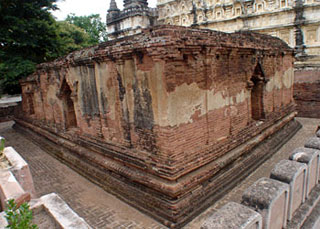 |
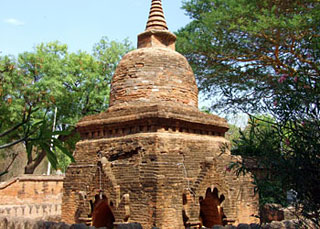 |
Seven sacred places
Seven places (or) Satta Htana After Gotama Buddha has gained the enlightenment. he stayed and meditated at seven places. each for one week. Therefore. there are seven holy places known as Satta Htana.
(1) MAHABODHI TREE AND THE GOLDEN THRONE
The first week. after gaining the enlightenment. Lord Buddha sat under the Mahabodhi tree and meditated.
(2) ANIMISA HILLOCK
The second week. Gotama Buddha gazed intently without on Animisa Hillock to his throne under the Mahabodhi tree.
(3) RATANACAR KRAMA
The third week. Buddha spent pacing up and down the jewelled walk. north of the Bodhi tree.
(4) RATANA GARA
The fourth week. Buddha stayed in this place and meditated. The Ratana Gara is now only seen as some ruins.
(5) AJAPALA BANYAN TREE (OR) SEIK KYAUNG NYAUNG PIN
The fifth week. Buddha was sitting under the Ajapala Banyan tree.
(6) MUSALINDA LAKE
The sixth week. Musalinda Naga (dragon) protected the Buddha from rain during the sixth week after the enlightenment.
(7) RAJARATANA TREE (OR) LINLUN TREE
The seventh week. the two merchants Tapussa and Bhalika offered rice cakes and honey to the Buddha under the Rajaratana tree (Buchanania latifolia) at the end of the seventh week.
Inscriptions and figures
ZThirteen lines of ink inscription are found on the eastern wall of the upper vaulted corridor. The lines say that the Pagoda was built and dedicated by Nan Taung Mya. son of King Narapatisithu. that the measurement of the land he donated to religion was recorded in history. that curse may befall those who destroyed his donated properties. and that he prayed and made vow. The north. south and west sides of the main structure were decorated with plaster mouldings. which include floral designs. birds and deva figures. There are 15 birds and 35 deva figurines on the south side. 10 deva figures on the west side and 18 birds and 35 deva figures on the north side.

